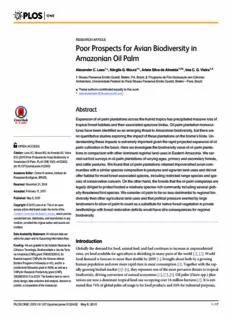
Poor Prospects for Avian Biodiversity in Amazonian Oil Palm PDF
Preview Poor Prospects for Avian Biodiversity in Amazonian Oil Palm
RESEARCHARTICLE Poor Prospects for Avian Biodiversity in Amazonian Oil Palm AlexanderC.Lees1*,NárgilaG.Moura1☯,ArleteSilvadeAlmeida1,2☯,ImaC.G.Vieira1,2 1 MuseuParaenseEmílioGoeldi,Belém,PA,Brazil,2 ProgramadePós-GraduaçãoemCiências Ambientais,UniversidadeFederaldoPará/MuseuParaenseEmílioGoeldi,Belém—Pará,Brazil ☯Theseauthorscontributedequallytothiswork. * [email protected] Abstract Expansionofoilpalmplantationsacrossthehumidtropicshasprecipitatedmassivelossof tropicalforesthabitatsandtheirassociatedspeciosebiotas.Oilpalmplantationmonocul- tureshavebeenidentifiedasanemergingthreattoAmazonianbiodiversity,butthereare noquantitativestudiesexploringtheimpactoftheseplantationsonthebiome’sbiota.Un- derstandingtheseimpactsisextremelyimportantgiventherapidprojectedexpansionofoil OPENACCESS palmcultivationinthebasin.Hereweinvestigatethebiodiversityvalueofoilpalmplanta- Citation:LeesAC,MouraNG,deAlmeidaAS,Vieira tionsincomparisonwithotherdominantregionalland-usesinEasternAmazonia.Wecar- ICG(2015)PoorProspectsforAvianBiodiversityin riedoutbirdsurveysinoilpalmplantationsofvaryingages,primaryandsecondaryforests, AmazonianOilPalm.PLoSONE10(5):e0122432. andcattlepastures.Wefoundthatoilpalmplantationsretainedimpoverishedaviancom- doi:10.1371/journal.pone.0122432 munitieswithasimilarspeciescompositiontopasturesandagrarianland-usesanddidnot AcademicEditor:ClintonNJenkins,Institutode offerhabitatformostforest-associatedspecies,includingrestrictedrangespeciesandspe- PesquisasEcológicas,BRAZIL ciesofconservationconcern.Ontheotherhand,theforeststhattheoilpalmcompaniesare Received:November21,2014 legallyobligedtoprotecthostedarelativelyspecies-richcommunityincludingseveralglob- Accepted:February11,2015 ally-threatenedbirdspecies.Weconsideroilpalmtobenolessdetrimentaltoregionalbio- Published:May8,2015 diversitythanotheragriculturalland-usesandthatpoliticalpressureexertedbylarge Copyright:©2015Leesetal.Thisisanopen landownerstoallowoilpalmtocountasasubstitutefornativeforestvegetationinprivate accessarticledistributedunderthetermsofthe landholdingswithforestrestorationdeficitswouldhavedireconsequencesforregional CreativeCommonsAttributionLicense,whichpermits biodiversity. unrestricteduse,distribution,andreproductioninany medium,providedtheoriginalauthorandsourceare credited. DataAvailabilityStatement:Allrelevantdataare withinthepaperanditsSupportingInformationfiles. Introduction Funding:WearegratefultotheInstitutoNacionalde Globallythedemandforfood,animalfeed,andfuelcontinuestoincreaseatunprecedented CiênciaeTecnologia,BiodiversidadeeUsodaTerra naAmazônia(CNPqgrant574008/2008-0),for rates,yetlandavailableforagricultureisshrinkinginmanypartsoftheworld[1],[2].World financialsupport;CNPqfortheSciencewithout fooddemandisforecasttomorethandoubleby2050[1],broughtaboutbothbyagrowing BordersProgram’sFellowshiptoACLandfora humanpopulationandevenmorerapidrisesinmeatconsumption[3].Togetherwiththerap- postdoctoralfellowshipgranttoNGM,aswellasa idlygrowingbiofuelmarket[4]–[6],theyrepresentoneofthemostpervasivethreatstotropical CNPqforResearchProductivitygrant(CNPq biodiversity,drivingconversionofnaturalecosystems[1],[7],[8].Oilpalm(Elaeisspp.)plan- 306368/2013-7)toICGV.Thefundershadnorolein tationsarenowadominanttropicalland-useoccupyingover16millionhectares[9].Itisesti- studydesign,datacollectionandanalysis,decisionto publish,orpreparationofthemanuscript. matedthat74%ofglobalpalmoilusageisforfoodproductsand24%forindustrialpurposes, PLOSONE|DOI:10.1371/journal.pone.0122432 May8,2015 1/17 BirdsinAmazonianOilPalmPlantations CompetingInterests:Theauthorshavedeclared thelatterpredominantlyforbiodiesel[10].ProductionisespeciallyprevalentinIndo-Malaysia thatnocompetinginterestsexist. (80%oftheglobaltotal),butplantationacreageisalsoincreasingrapidlyintheAfro-andNeo- tropics[11],[12].Thisrapidexpansionislikelytocontinuefordecadesgivenbothhighprofit- abilityandhighdemand.Proponentsofpalmoilemphasizethatitsmainalternatives, includingsoy,sunflower,andcanolaoils,haveproductionefficienciesjust10–20%ashighas palmoil(onaper-hectarebasis)andwouldthereforerequiremuchlargerareasofcultivated landtohaveasimilarbenefit[13],moreover,theindustryisalsohighlylucrativeandcouldpo- tentiallycreatethousandsofnewjobsandraiseregionalstandardsofliving. Althoughwidelyflaggedasagreenfuel,fromclimate-changeandbiodiversityperspectives, suchadvantagesarediminishedshouldpalmoilproductioncontributeeitherdirectlyorindi- rectlytodeforestation[10],[11].Thishasproventobethecaseinmanypartsoftheworld, whereexpansionhascomeattheexpenseofbothundisturbedandloggedprimaryforest[8], [12],[14]despitethehighbiodiversityvalueassociatedwithevendegradedprimaryforests [15].Thislossisalsopartiallyduetoplantationownersusingtimberrevenues(fromprimary forests)toprovideset-upcostsforplantationestablishmentandmaintenance[14].Thusthe questionofhowtomakeoilpalmamoreenvironmentallyfriendlycropbecomesofcritical conservationimportance[16–18].Asmitigationmeasures,insitupracticestoenhancelocal biodiversity;suchasproductionofoilpalmbeneathshadetrees,diverseagro-forestryonplan- tationboundaries,andmaintenanceofforestpatcheswithinplantationshavebeenproposed [18–21].Significantenvironmentalprogresshasalsobeenmadeundertheauspicesofthe RoundtableonSustainablePalmOil(RSPO)certificationprogram[22],aresultofmanyofthe largestpalmoilproducersdesiretoimplementenvironmentally-friendlymanagement. TheBraziliangovernmentisplanningalargeincreaseinbiofuelproductionoverthenext decade,drivenbyinternalandexternalmarketdemand(ethanol),aswellasbygovernment- enforcedblending(biodiesel)[23–25].MuchofthisexpansionisforecastfortheeasternAma- zonianstateofParáwherethepalmoilacreagedoubledbetween2004and2010[25].Bastos etal.[26]suggestedthatupto80%ofthestatewouldbesuitableforoilpalmcultivation,with degradedlands(suchasabandonedcattlepasture,andminingareas)likelytohostmuchofthe growthinproduction.TheEnvironmentalCouncilofParáState(COEMA)recentlypasseda resolution[27]thatpermitsthedesignationofoilpalmasa‘low-impact’land-usethatmay substitutenativeforestvegetationinthelegally-mandatedpermanentprotectionareas(áreas depreservaçãopermanente)‘APPs’andlegalreserves(reservaslegais)‘RLs’requiredofsmall- holderpropertiesoflessthan20ha.Withthisprecedentthereisnowapowerfulrurallobbyar- guingforthisdispensationtobeavailabletoalllandowners,irrespectiveofpropertysize[28], asareplacementforregeneratingforestvegetation.GiventhattheforestsoftheAmazonbasin, representingabout41%oftheworld'sremainingtropicalrainforestarealreadysubjecttode- forestationratesfluctuatingaroundhalfamillionhectaresperyear[29],thisexpansioninto Amazoniarequirescarefulappraisalofthepotentialimpactsofoilpalmmonoculturesonthe region’srichbiodiversity.Suchimpactshavebeenheavilystudiedinsouth-eastAsia,where evenwildlife-friendlymanagementtechniqueshavefailedtoconservespeciesofconservation concerne.g.[30],buttherearenosuchquantitativestudiesfromAmazonia.Decisionsabout howtobalancelandrequirementsforagriculturebiofuelsandbiodiversityconservationwill thushaveprofoundeffectsontheconservationofAmazonianbiodiversity,aswellaseconomic developmentandpovertyalleviation[31]. Hereweevaluatethevalueofoilpalmplantationsforavianbiodiversityinrelationtoother localland-uses(primaryandsecondaryforestsandcattlepastures)locatedinthe145,000km2 BelémAreaofEndemism(hereafterBelémAE),aregionofeasternAmazoniadelimitedbythe eastbankoftheTocantinsriverandthewesternbiogeographiclimitofAmazonianterrafirme forestsinwesternMaranhãostate[32].TotalforestlossintheBelémAEhasreachedatleast PLOSONE|DOI:10.1371/journal.pone.0122432 May8,2015 2/17 BirdsinAmazonianOilPalmPlantations 75%oftheoriginalextentandfurtherextensiveforestlossandconcomitantglobalextinctions areforecastifeffectiveforestconservationpoliciesarenotenforced[33],[34].Weinvestigate theavianbiodiversityvalueofoilpalmlandscapesintermsofplantationage,treespeciesrich- nessanddistancetosourcehabitatsandcomparethesevalueswiththoseofland-usesinthe surroundinglandscapematrix(pastoralsystems,primaryandsecondaryforests). MaterialsandMethods StudyRegion ThisstudytookplaceinthemunicipalitiesofMoju,TailândiaandAcarálocatedcirca120km southofBeléminParástate.Meanannualtemperatureis26.6°C,meanannualprecipitationis circa2,500mm[35]andlocalsoilsarehighlyweatheredacidoxisols[36].Forestcanopy heightsaretypicallyintherangeof25–35mandtheunderstoreyisdominatedbyplantsfrom thefamiliesLecythidaceae,Violaceae,Sapotaceae,Burseraceae,MoraceaeandLeguminosae [37].Therearealsosmallpatchesofnaturalopenvegetationenclaves—campinaformationson whitesandsoilswhichhaveaverydistinctbiodiversity[38].Bytheyear2010,forestcoverin TailândiaandMojuhadbeenreducedby45%to4,989km2muchofwhichisdegradedprima- ryorregeneratingsecondaryforest(Fig1and[29]).Thesetwomunicipalitiesformpartofthe oilpalm‘pole’ofMoju-Acará-Tailândia,where124,700haofoilpalmhadbeenplantedby 2009,predictedtoincreaseto370,500haby2014[39]. Datacollection Weselectedthreestudyregionsoccupiedbydifferentoilpalmproducers,asfollows:Ubá (1,008km2)inthenorthofthemunicipalityofMojuincludingthesourceoftherioUbá;Ara- uai(952km2)locatedinthecentreofthemunicipalityincludingthesourceoftherioArauai; andfinallyMamorana(680km2)locatedatthesouthernextremeofthemunicipalityincluding thesourceoftherioMamorana(forfurtherdetailssee[40]).Between15–17300mtransects wereallocatedtoeachregion,distributedusingastratified-randomsamplingdesign(wherea standarddensityoftransects(1per400ha)wasdistributedinproportiontothepercentage coveroftotalforestandproductionareas)acrosseachregiontoincreasethelikelihoodthat theywouldcaptureimportantinternalheterogeneitiesinforestand/orproductionsystems.To reducethedependencybetweentransectswithineachregion,transectswereseparatedbya minimumdistanceof1.5km.Wealsoavoidedplacingtransectswithin200mofanyother land-usetocontrolforpotentialedgeeffects. Intotalwesampled50transects,17inprimaryforest,4insecondaryforests—foreststhat developedaftercompletedeforestation[41]ofdifferentages(5,7,15&20yearsold),15invar- iable-ageoilpalmplantations(1,3,4,12,14,23,24&25yearsold),12incattlepastureandone incampinavegetation(althoughthelatterwasnotusedinlateranalysesexceptFig.CinS1 File).Designationofsecondaryforestandplantationageswasdonethroughvisualinspection ofa20yeartime-seriesofLandsatimagesforeachtransect,calibratedbyinterviewswithlocal farmers.Allprimaryforestsiteshadbeensubjecttohistoricselectiveloggingeventsbutnone havebeenburnedinthelastfiveyears.Allfieldworktookplaceonprivatelandsandlandown- ersineachregionwerevisitedpriortoanyfieldworktointroducetheprojectandsecureper- missionsforsurveys.Land-useclassificationwasundertakenusingArcGis9.3andEnvi4.5 usingbothunsupervised(ISODATA)andsupervised(MaxVer)classificationprotocols(ISO- DATA)[40].TheISODATA(InteractiveSelf-organizingDataAnalysis)methodwasusedto determineland-useclassespriortofieldworkandemployedminimumEuclideandistance measurements(inmultidimensionalspace)toidentifyspectralclustersfromtheimageandas- signaclasstoeachpixel.Onreturningfromthefieldwithourground-truthedmeasurements PLOSONE|DOI:10.1371/journal.pone.0122432 May8,2015 3/17 BirdsinAmazonianOilPalmPlantations Fig1.Mapofthestudyregiondepicting(a)thethreeareasstudiedwiththemunicipalityofMojuandland-usetypes;thedistribution(b)of transectsacrossonestudyarea(Arauai)anditsland-uses;andc)transectdesigndepictingvegetativesamplingplotsandsub-parcelsandthe positionofpointcountstations. doi:10.1371/journal.pone.0122432.g001 weperformedasupervisedMaxVer(MaximumLikelihoodClassification)analysiswhichas- signstheprobabilityofeachpixeltopre-definedclasses(basedonourground-truthing),as- signingpixelstotheclasswiththehighestprobability.Toassessclassificationaccuracyweused Cohen’sKappastatistic[42],whichprovidesanindicationoftheclassificationagreementbe- tweentheclassifiedandtheground-truthedmapsthatisnotattributabletochance.Theremote sensinganalysiswasperformedusinggeoreferenceddatawithLandsatTM-5(ThematicMap- per)imageswith30mspatialresolutionfromtheyear2010. Tosamplethebirdcommunitywelocatedthreepointcount(PC)stationsineachtransect at0,150and300m.Atotalof288PCswereconductedbetweenthethreeregions.We(ACL& NGM)carriedouttworepetitionsofthree15minute,75mfixedradiusPCspertransect,re- cordingallspeciesseenorheard.Repetitionsensuredthattemporalvariationinavianvocalac- tivitywasminimized,andPCswererecordedusingsolidstaterecorders.Theavifaunalsurveys werecomplementedwithsamplingofwoodyplantsandvegetativestructuretoseehowhabitat structuralcharacteristicsandbotanicdiversitymightinfluenceavianspeciesrichness.These surveystargetedtreesandlianasandpalmsabove2cmDBH(DiameteratBreastHeight)and wereconductedin10x250mplots,subdividedinto10x(10x15m)parcelsfollowingthepro- tocolsofGardneretal.[43].Allindividualswereidentifiedtospeciesormorphospeciesbyex- pertparabotanists(NelsonRosaandCarlosAlbertoSantos).Plantspecieswhichdefiedfield identificationwerecollectedanddepositedintheherbariumoftheMuseuParaenseEmílio Goeldiforlateridentification.Togeneratebiomassestimates(asMg.ha-1)weusedallometric equationsforallplantspecieswithDBH(cid:1)2cm. PLOSONE|DOI:10.1371/journal.pone.0122432 May8,2015 4/17 BirdsinAmazonianOilPalmPlantations WeusedtheequationsofChaveetal.[44]forhumidforesttreespecies: ðAGBÞest¼p (cid:3)expð(cid:4)1:499 þ2:1481 (cid:3)lnðDBHÞ þ0:207 (cid:3)ðlnðDBHÞÞ2 (cid:4)0:0281 (cid:3) ðlnðDBHÞÞ3 where:AGB=abovegroundbiomassforallspecieswithDBH(cid:1)2cm;p=wooddensity (g/cm-3);andDBH=diameteratbreastheight(cm).Weusedagenera-specificequation forpalmsinthegenusCecropia,thatofNelsonetal.[45]: DW¼expð(cid:4)2:5118 þ2:4257 (cid:3)lnðDBHÞÞ whereDW=estimatedbiomassofCercropiasp.trees.Finallytogenerateestimatesofthebio- massofoilpalmElaeisguineensisweusedtheage-specificformulaofCorley&Tinker[46]: Bt¼p (cid:3)ðr (cid:3) Z2Þ(cid:3)100(cid:3)h (cid:3)r whereBt=estimatedbiomass(kg)ofElaeisguineensis;r=radius(cm)ofthepalm’strunk; Z=diameterofthepalmbase(aconstant—0.777),ρ=height(m)ofthetrunkandρ=trunk density(Kg/m3)whichiscalculatedusingtheformula: Id(cid:3)0:0076þ0:083 r¼ 1000 WhereIdistheageoftheoilpalminyears. Dataanalyses Weanalysedtheresponsesoftotalspeciesrichnessaswellasrichnessandturnoverforthesub- setof‘primaryforest-associatedbirds’(hereaftertermed‘forestbirds’).Theseforestbirdsrep- resentthecoreavifaunaofundisturbedterrafirmeforestsbutnotnecessarilybirdsrestrictedto thosehabitats,assomecoreprimaryforestspeciesalsooccurinhuman-modifiedforestand non-foresthabitats(e.g.Blue-grayTanagerTangaraepiscopusandBananaquitCoerebafla- veola).Thesecategorizationswerebasedonpreviouslypublishedclassificationofbirdsfrom theregione.g.[47]and[48].OurtaxonomyfollowsthechecklistofBrazilianbirdscompiled bytheComitêBrasileirodeRegistrosOrnitológicos[49]. Tocomparesamplingintensityandavianresponsesbetweendifferentland-usesweused sample-basedrarefactioncurves,with95%confidenceintervalscalculatedusingthe‘specac- cum’tool,includedintheveganpackageoftheRsoftware[50].Comparisonsbetweenspecies richnessineachland-usetypeweremadeusingaone-wayANOVAtestwithintervalsfollowed byaTukeypost-hoctesttocheckforsignificantpairwisedifferences.Toexploreunivariaterela- tionshipsbetweenforestcoverandforestbirdspeciesrichnessweperformedlinearregressions usingpercentageoftotalforestcover(primaryandold(>15years)secondaryforestscombined ina1kmbuffer),thepercentageofprimaryforestcoverina1kmbufferaroundthecentroid ofeachtransect(tostandardisesamplingunitsize)anddistancetothenearestprimaryforest aspredictorvariablesforavianspeciesrichness. Toassesstherelativeimportanceofdifferentenvironmentalvariablesonbirdspeciesrich- nesswefirstassessedforvariablecolinearityusingPearsoncorrelationbetweenthevariables, edgedistance,treespeciesrichness,plantsbiomassandpercentageofprimaryforestcoverex- cludingvariableswithanunacceptably-highdegreeofcolinearity(r(cid:1)0.7).Wethenusedgen- eralizedlinearmodels(GLMs)withaGaussiandistributionandaloglinkfunctionandmodel averagingusingAICcweights[51]togeneratesubsetsoftopmodelsanduncovertherelative importanceofdifferentvariables.AlltheseanalysisweredoneusingRversion2.15.1[50]with the‘glmulti’and‘MuMin’packages. PLOSONE|DOI:10.1371/journal.pone.0122432 May8,2015 5/17 BirdsinAmazonianOilPalmPlantations Toassessthevariationinspeciescompositionbetweenland-usesystemsanddifferentpri- maryforestdisturbanceclassesweproducednon-metricmulti-dimensionalscalingordina- tions(nMDS[52])usingtheSorensensimilaritymatrixforspeciespresence-absencedata.To assessthestatisticalsignificanceofdifferencesinassemblagecompositionbetweendifferent land-usetypesandforestdegradationclassesweconductedaone-wayPERMANOVAwhich usespseudo-Fvaluestocompareamong-grouptowithin-groupsimilarityandassessessignifi- cancebypermutation.AllmultivariateassemblageanalyseswerecarriedoutinPrimerv.6 (PRIMER-ELtd,Plymouth,UK,[53]).Tofacilitatecomparisontoalargersampleofdifferent land-useswecomparedourdatafromMoju-Tailândia-Acaráwithdatafromanextensivein- ventoryoftheneighbouringmunicipalityofParagominas[41].Thisinventoryusedthesame transectselectionandaviansamplingprotocolsandhasthesamesourceavifauna[54],[55]as thepresentstudyandwasconductedbythesamefieldornithologists(ACL&NGM).Intotal weusedaviandatafrom187transects—97inprimaryforest,25insecondaryforest,53incattle pastureand12frommechanisedagriculture(soybeanfieldsinthiscase).Weinvestigatedrela- tivecontributionofindividualspeciestotheoveralldissimilarityusingthesimilaritypercent- agesroutine-SIMPER[50].Owingtohistoriclegacyeffectsoflandpurchasing(with smallholderpropertiestypicallyclosertoforestborders),oilpalmplantationswereonaverage situatedfartherfromprimaryforestborders(mean=972m,SD=267m,range545–1424m) thancattlepastures(mean=510m,SD=150m,range216–719m).Tocontrolforthispoten- tialbiasofleakageofforestspecieswecomparedoilpalmforestbirdrichnesswithforestbird richnessfromcattlepastures(n=23mean=1009m,SD=382m,range554–2069m)inPara- gominassituatedover550mfromthenearestprimaryforestborderandassessedthesignifi- canceofdifferenceswithapairedt-testusingR. Finally,weusedaglobalphylogenyofbirds[56]tovisuallycomparethephylogeneticstruc- tureofthemostspecioseavianclades(familieswith>8species)betweenthedominantregion- alland-uses(primaryforest,pastureandoilpalm).Theresultingcircularphylogramswere visualizedandeditedusingtheFigTreev1.4.1software(http://tree.bio.ed.ac.uk/software/ figtree/)todocumentnon-randomextinctionprocesses. Results Regionalland-useclassification Acrossthe2,588km2studyregionourremote-sensinganalysisidentifiedsevendiscreteland-use types:varyingly-degradedprimaryforest:40.2%(1041km2),secondaryforest:9.0%(234.9km2), campinaformations:2.8%(71.8km2),oilpalmplantations:8.3%(214.9km2),cattlepasture: 39.2%(1016km2),openwater:0.3%(9.0km2)andcloud/shadow:0.01%(0.15km2).Thesere- sultswereassociatedwithaKappacoefficientof0.85(withaglobalaccuracyof89%ofthepixels correctlyclassified).FollowingMonserudandLeemans[57]Kappastatisticsvalues,from0.7to 0.85representverygoodagreementbetweenimages. Speciesrichnessbetweenland-usetypes Werecorded3,090detectionsof249birdspecies,ofwhich1982wereforest-associatedspecies (forafulllistseeTableAinS1File).Thespeciesaccumulationcurvesindicatedthatsurveysin mostland-usetypeswerenearasymptotic(FigAinS1File).Werecordedmeanspeciesrichness pertransectof50.1inprimaryforest(SD=13.2,n=16,totalrichness=211,range=24–69,), 33.25insecondaryforest(SD=2.3,n=4,totalrichness=68,range=30–36),30.0incattlepas- ture(SD=7.9,n=12,totalrichness=100,range=17–41),and16.3inoilpalmplantation (SD=6.9,n=15,totalrichness=69,range=6–28).Thesedifferencesinspeciesrichnessweresig- nificantbetweenallland-usetypesconsideringthewholeavifaunalcommunity(Fig2A,F=32; PLOSONE|DOI:10.1371/journal.pone.0122432 May8,2015 6/17 BirdsinAmazonianOilPalmPlantations Fig2.Boxplotscomparingavianspeciesrichnessbetweenland-usetypes,usingtheentireavianassemblage(A)andjustforest-associatedbirds (B).Non-significantpairwisedifferencesbetweenland-usetypesareindicatedbythepresenceofthesameletter(accordingtoaTukeytest95%). doi:10.1371/journal.pone.0122432.g002 df=43;N=4;P<0.01)andforforest-associatedbirds(Fig2B,F=46;df=43;N=4;P<0.01), withtheexceptionofthosebetweenpastureandsecondaryforestsforwhichthemeandifferences richnesspertransectwasstatisticallynon-significant(Fig2).Thedifferenceinforestbirdspecies richnesswasnotsignificantbetweenoilpalmandcattlepastures(mean=4.34,SD=2.19,n=23) situatedover500mfromthenearestprimaryforestinParagominas(unpairedt-test,t=1.7; df=36;P=0.09,Fig.C,inS1File).Wefoundthatavianspecieswasstatisticallydifferentbetween old(>11years,n=6,meanspeciesrichness:10.2)andyoung(<10years,n=8,meanspecies richness:21.5)oilpalmtransectsforboththeentireaviancommunity(F=29.4;df=13;P<0.01) andforest-associatedbirdsonly(F=18.7;df=13;P<0.01).Furthermore,aviancommunitiesin oilpalmplantationsofvaryingagesunderwentaviancommunitysuccessionresultingindifferent communitystructureandrichnessbetweenplantationsofdifferentages(FigC,inS1File).Re- centlyplantedstands((cid:5)1–2years)hadaverylowvegetativebiomassandweremostlyoccupied bybirdstypicalofcattlepastures(ornaturalsavannahenclaves—see[38])suchasPale-breasted SpinetailsSynallaxisalbescensandRed-breastedBlackbirdsSturnellamilitaris.Plantationsof(cid:5)5 yearshadamoresignificantbiomasscomparablewithyoungsecondaryforests,buthadasimilar communitystructure,albeitincludingsomespeciesmoretypicalofedge/secondaryforestsuchas ReddishHermitPhaethornisruber,GreatAntshrikeTarabamajorandWhite-fringedAntwren Formicivoragrisea. Environmentaldeterminantsofspeciesrichness Wefoundasignificantpositiveandbroadlylinearrelationshipbetweentherichnessofallbird speciesandtreebiomass(adj.R2=0.49,p<0.001)whichstrengthenedwhenonlyforestasso- ciatedbirdswereincludedinthemodel(Fig3,adj.R2=0.70,P<0.001).Weuncoveredasig- nificantnegativerelationshipbetweendistancetoforestedgeandspeciesrichness(adj.R2= 0.56,P<0.001)whichwasmarginallymoresignificantwhenonlyforestbirdswereretained (Fig3,adj.R2=0.56,P<0.001).TheGLMsrevealedthattreerichnesswasthemostimportant predictorvariableinfluencingrichnessforthewholecommunity(Fig4andTableBinS1File) followedbydistancetotheforestborder,forestcoverandvegetativebiomassforthewhole PLOSONE|DOI:10.1371/journal.pone.0122432 May8,2015 7/17 BirdsinAmazonianOilPalmPlantations Fig3.Linearregressionsbetweenrichnessofforestbirdspeciesanda)treebiomassandb)distancetothenearestprimaryforestborder. doi:10.1371/journal.pone.0122432.g003 community,whilstforforestassociatedbirdsthemostimportantpredictorvariablesweretree speciesrichness,biomass,distancetotheforestborderandforestcover.Thetopmodelresults showedthat,consideringthewholeaviancommunity,fourmodelshadlowΔAICc(<2),with thebestmodelincludingdistancetoborderandtreerichness.Consideringonlyforest-associat- edbirdstwomodelshadlowΔAICcwiththebestretainingonlytreespeciesrichness(TableB inS1File). Fig4.Relativeimportanceofenvironmentalvariablesinexplainingtotalavianspeciesrichness(A)andforest-associatedbirdrichness(B).Signs indicatethedirectionoftheeffectofeachvariable.Theexplanatoryvariablesincludedistancetotheforestborder(border),treespeciesrichness,forest cover(%ofprimaryforestcover)andbiomassoftrees(biomass). doi:10.1371/journal.pone.0122432.g004 PLOSONE|DOI:10.1371/journal.pone.0122432 May8,2015 8/17 BirdsinAmazonianOilPalmPlantations Aviancommunitystructureacrossland-usetypes Avianspeciescompositionchangedconsistentlyandsignificantlyalongagradientofhuman impactsbetweenprimaryforests,secondaryforests,cattlepasturesandoilpalmplantations Fig5,TableCinS1File,PERMANOVA,Pseudo-F=8.1725,P<0.001).Allspeciesassem- blagesweresignificantlydifferentfromeachother(P<0.001)withtheexceptionofpastures andplantationsforwhichP=0.573.Communitystructureinprimaryforests,secondaryfor- estsandcattlepasturewasbroadlysimilartothatfoundintheneighbouringmunicipalityof Paragominas(Fig5)indicatinglowspeciesturnoverbetweenthemunicipalitiesandemphasis- ingthegeneralizabilityoftheresultsacrosstheBelémAE.Eachland-usetypeplayedhostto characteristicassemblagesofspecieswhoserelativedominancecontributedtocommunitydis- similarity(Table1),withcommunitiesintheoilpalmplantationssharingmorespecieswith cattlepasturesthantheydidwithforesthabitats.Thephylograms(Fig6)indicatethatland-use mediatedlocalextinctionswerenon-random,withgreatestlossesofspeciesoccurringfromthe diverseradiationofsuboscinepasserines(antbirds,tyrantflycatchers,ovenbirdsandwood- creepers)forwhichfewspeciespersistedincattlepasturesoroilpalmplantations.Therewas someturnoverofspecies,withwaterbirdssuchascrakesandrailsanddiversegranivorousos- cinepasserinestypicalofopenareascolonisingthepasturesandoilpalmplantations(Fig6. TableAinS1File). Occurrenceofthreatenedandendemicspecies Mostofthebirdspecies(96%)wedetectedareclassifiedasLeastConcernbyBirdLifeInterna- tional[58]withtheexceptionofninespeciesinthethreatcategoriesEndangered(EN),Vulner- able(VU)andNearThreatened(NT).Thesewereasfollows:White-crestedGuanPenelope pileata(VU);RuddyPigeonPatagioenassubvinacea(VU);GoldenParakeetGuarubaguar- ouba(VU);White-belliedParrotPionitesleucogaster(EN);PearlyParakeetPyrrhuralepida Fig5.NMDSplotsofcommunitystructureoftheaviancommunityinMoju(polygonswithheavyblack borders)andParagominas(narrowborders),primaryforesttransectsarerepresentedbydarkgreen squares,secondaryforestsbylightgreensquares,orangecirclesarecattlepastures,greycirclesare mechanisedagricultureandtrianglesareoilpalmplantations(darkred=15–20yearsold,lighterred 0–6yearsold). doi:10.1371/journal.pone.0122432.g005 PLOSONE|DOI:10.1371/journal.pone.0122432 May8,2015 9/17 BirdsinAmazonianOilPalmPlantations Table1. Thetop-ranked15birdspeciesineachland-usetypewhichcontributedtothedissimilarityofspeciescompositionbetweenoilpalmplan- tations,cattlepastures,secondaryforestsandprimaryforests. OilPalm Pasture Latinbinomial Av.Abund Contrib% Cumu.% Latinbinomial Av.Abund Contrib% Cumu.% Formicivoragrisea1 1 20.7 20.7 Myiophobusfasciatus2 0.92 7.54 7.54 Tyrannusmelancholicus 0.8 11.89 32.59 Tangaraepiscopus 0.92 7.54 15.09 Ramphoceluscarbo4 0.67 8.33 40.92 Tyrannusmelancholicus 0.92 7.54 22.63 Tangarapalmarum 0.53 5.48 46.41 Troglodytesmusculus2 0.85 6.4 29.03 Myiophobusfasciatus2 0.6 5.19 51.6 Elaeniaflavogaster 0.85 5.97 35 Troglodytesmusculus2 0.53 4.76 56.36 Phaeomyiasmurina 0.85 5.97 40.97 Pitangussulphuratus 0.47 3.79 60.15 Ramphoceluscarbo4 0.85 5.41 46.38 Turdusleucomelas 0.4 3.48 63.62 Synallaxisalbescens2 0.69 4.14 50.52 Phaethornisruber3 0.4 3 66.63 Tangarapalmarum 0.69 4.06 54.58 Sturnellamilitaris2 0.47 2.93 69.56 Volatiniajacarina2 0.69 3.93 58.51 Volatiniajacarina2 0.47 2.93 72.49 Sturnellamilitaris2 0.62 3.64 62.15 Prognechalybea3 0.4 2.68 75.17 Formicivoragrisea 0.62 2.82 64.97 Synallaxisalbescens2 0.4 2.11 77.28 Prognechalybea3 0.54 2.27 67.24 Crotophagaani 0.4 2.02 79.3 Tachyphonusrufus 0.54 2.26 69.5 Amazonaamazonica 0.33 1.78 81.09 Myiarchustyrannulus 0.54 2.17 71.67 SecondaryForest PrimaryForest Latinbinomial Av.Abund Contrib% Cumu.% Latinbinomial Av.Abund Contrib% Cumu.% Coerebaflaveola2 1 6.11 6.11 Cercomacracinerascens 1 4.54 4.54 Formicivoragrisea 1 6.11 12.22 Lophotriccusgaleatus 1 4.54 9.09 Phaethornisruber3 1 6.11 18.34 Phaethornisruber3 0.93 4.04 13.13 Pheugopediusgenibarbis 1 6.11 24.45 Myrmotherulaaxillaris2 0.93 3.97 17.1 Prognechalybea2 1 6.11 30.56 Pyriglenaleuconota2 0.93 3.94 21.03 Pyriglenaleuconota2 1 6.11 36.67 Glyphorynchusspirurus 0.87 3.32 24.36 Ramphoceluscarbo4 1 6.11 42.78 Myiopagisgaimardii2 0.8 2.97 27.33 Thamnophilusamazonicus 1 6.11 48.89 Pheugopediusgenibarbis 0.8 2.78 30.11 Amazonaamazonica 0.75 3.14 52.04 Ramphoceluscarbo4 0.8 2.78 32.88 Manacusmanacus 0.75 3.14 55.18 Thamnomanescaesius 0.8 2.62 35.5 Patagioenasspeciosa 0.75 3.14 58.32 Isleriahauxwelli 0.73 2.25 37.75 Saltatormaximus 0.75 3.14 61.46 Coerebaflaveola2 0.73 2.22 39.97 Lophotriccusgaleatus 0.75 3.08 64.53 Zimmeriusgracilipes 0.73 2.15 42.12 Myiopagisgaimardii2 0.75 3.08 67.61 Thamnophilusamazonicus 0.67 2.11 44.23 Myrmotherulaaxillaris2 0.75 3.08 70.69 Ramphastosvitellinus 0.67 1.89 46.12 Numberedsuperscriptsrefertothenumberofotherhabitatsinwhichspecieswerealsotop-rankedcontributorstospeciessimilarity. doi:10.1371/journal.pone.0122432.t001 (VU);VulturineParrotPyriliavulturina(VU);(Eastern)Red-neckedAracariPteroglossus bitorquatus(EN);Red-billedToucanRamphastostucanus(VU);Channel-billedToucanRam- phastosvitellinus(EN)(asArielToucanRamphastosariel)andLong-tailedWoodcreeperDeco- nychuralongicauda(NT).Allthesespecieswereconfinedtoprimaryforests;withthe exceptionofasingleRed-neckedAracariphotographedinanarborescentpasture[59]andone recordofChannel-billedToucanfromasecondaryforesttransect(TableAinS1File).Inaddi- tionwefoundafurtherfourspecieswhicharenarrowlyendemictotheBelémAE(andafur- therfourhighly-differentiatedendemicsubspecieslikelytobesubjecttofuturetaxonomic upgradestospeciesstatus[60–62])andsixotherspeciesthatarerestrictedtosouth-east PLOSONE|DOI:10.1371/journal.pone.0122432 May8,2015 10/17
Description: